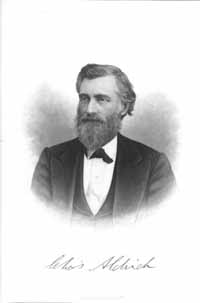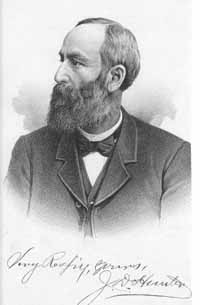The Hamilton Freeman - 145 Years of Service
By Martin E. Nass
Transcribed for the IAGenWeb Project by Janelle Martin, with permission of Martin "Ed" Nass.

Searching for a place to start a newspaper, Charles Aldrich came to
Webster City, Iowa, in May of 1857. He met with the leaders of the new
city about the prospects and he was given assurance that he would be
able to get 500 subscribers. He was offered a $500-bonus if he would
come here. He had apprenticed to the printer's art, working on
newspapers in New York and Pennsylvania. He then established the
Journal in Olean, New York, in 1850, which he published for five years.
With the assurances given him, he acquired his press and equipment and
had it delivered to Dyersville, then the end of the railroad line. John
Meeks of Webster City was hired to haul the press, type, and office
fixtures over prairie roads and through the "bottomless sloughs." At
that time our little village had only 400 inhabitants; the entire county
had less than 1,500, most of whom were located in Homer. Aldrich
declared his paper to be a Republican newspaper. He set up his business
near the northwest corner of Bank and Seneca, just west of the L. L.
Estes Drug Store. The subscription price per year was $2.00. Later this
price was $1.75 paid in advance.
The name chosen for Aldrich's newspaper came about when, at the age of
19, he was chosen secretary of the first Freesoil organization, an
anti-slavery group. The name "The Hamilton Freeman" was chosen to
reflect his staunch feeling against slavery.
On June 29, 1857, the first copy of the Hamilton Freeman came off the
press. This was exactly 145 years ago. The first subscriber was Robert
Willis, a farmer who lived on a farm on White Fox Creek. Fortunately,
copies of these papers have all been copied to microfilm. They give an
excellent reference for historians. One original copy has been framed
and hangs in the office of the Daily Freeman-Journal today.
In the beginning, the Freeman consisted of only four pages, two
containing local news and ads. In those early days Aldrich gave accounts
of the Spirit Lake Massacre, the concerns of the pioneer village, and
information about the Civil War. Since his feelings against slavery were
so strong, he locked up his newspaper office in 1862 and enlisted in the
Union Army. He became adjutant of the Thirty-second Iowa Infantry and
served for eighteen months. He reached the rank of Major.
During the Civil War Aldrich sold the Freeman to V. A. Ballou, his
assistant in 1864. After the war, Aldrich published and edited
newspapers in Dubuque, Marshalltown, and wrote for several Chicago
newspapers. He served in the Iowa Legislature and secured passage of a
law protecting our harmless and useful birds. He helped develop the Iowa
State Historical Department, becoming its first curator, a position he
held until his death.

Ballou operated the paper for two years, when he decided to sell out and
continue his education. In 1866 J. D. Hunter bought the Freeman and
moved it to the upstairs of Henry McKee's hardware store on the
northeast corner of Bank and Seneca in a building he owned. This
building later became the Forrester Dairy Drive-In. Hunter had a great
deal of experience, having published newspapers in Indiana; the Marion
Register of Marion, Iowa; and the Hardin County Sentinal of Eldora.
Hunter sold the paper to T. E. McCracken in 1874, but he returned as
publisher and editor in 1875. During McCracken's tenure, C. D. Hellen
was hired at age 14 to become the "printer's devil." Hellen later went
on to establish a rival newspaper, the Webster City Tribune. It was
later merged with the Freeman in 1885.
The third location of the Freeman was at 913 Seneca Street on the
second floor of that brick building. Today the Bottorff law offices
occupy this site. Hunter was the publisher and editor; his sons Dwight
and Will assisted him. Will Smith was the foreman and pressman. This
building was built by Jay Sternberg, who operated a hardware store on
the first floor at the time.
Hunter constructed the brick building in 1877 at the southwest corner of
Second and Seneca Streets. The newspaper was located in the rear of the
second floor. In 1873 Hunter received appointment as Postmaster of
Webster City by President Grant. The post office was located on the
first floor under the newspaper office with a front door on Seneca
Street. J. D.'s son, Will F. Hunter, took over the operation of the
newspaper. In 1885 President Cleveland removed J. D. from his office for
"offensive partisanship."
The fifth location of the Freeman was on Second Street in the
Syndicate Block, another building constructed by J. D. Hunter. The
newspaper operated on the second floor above Mason Hardware. It was
adjacent to the First National Bank operated by Kendall Young.
The sixth location was 623 Second Street, the building now the law
office of Patrick Chambers. The name of the paper was changed again.
From 1891 to 1917 it was called the Webster City Freeman. The presses
were located in the basement. It stayed in this location for a long
time, finally making the final move to 720 Second Street where it is
located today.
In 1871, Lewis Rabiner started the Index, located on the second floor
above the Little Chicago Café. It was the first Democratic newspaper in
our city. The Argus was started in 1875 by S. T. Edwards and C. G.
Bundy. G. M. Blair was the publisher of this paper in 1885. The Webster
City Tribune was started in 1885 by C. D. and W. H. Hellen. They also
ran another newspaper, the Argus, in the early 1880's. The Graphic,
a semi-weekly, was started in 1896 and operated for five years. T. Leroy
Evans was the publisher and editor. The Webster City Daily News was
published by Fred Hahne in the early 1920's. Effie Kantor was the editor
of this little paper. Ray O. Clemson started the Public Press in 1934.
He was both publisher and editor. Hahne started another paper in the
1940's, calling it the Webster City Observer. Ted Amsden was named the
managing editor.
The name of the Hamilton Freeman changed many times in the 145 years
of operation. It started as a weekly newspaper. In July, 1895, C. D.
Hellen and J. D. Hunter combined their newspapers to form the
Freeman-Tribune, a daily newspaper. Hunter continued with his Weekly
Freeman and Hellen continued with his Weekly Tribune. The Hunter
family has been involved with the newspaper for much of its life. In
1917 Tucker and Hunter joined their papers to form the Daily
Freeman-Journal. J. D. was editor until 1902; W. F. was co-editor with
George C. Tucker, former editor of the Webster City Journal until
1945. The Daily Freeman-Journal was then purchased by Hunter's
daughters and sons-in-law, Mr. and Mrs. Jack Bladin and Mr. and Mrs.
Charles Warren. The Bladins sold their interest to Mr. and Mrs. Lloyd
Karr. In 1950 Chuck Warren entered the radio business when he developed
the Station KJFJ. The FJ in the call letters stood for
Freeman-Journal. This station still operates today as KQWC.
In 1953, the Hunter family ownership ceased when the paper was purchased
by B. F. Shaw Publishing Company. W. J. Carmichael served as publisher;
Max Maxon was the editor. Maxon spent 50 years with the Daily
Freeman-Journal. In 1972, our newspaper was purchased by the Ogden
Newspapers, Inc. group. The current publisher is Mike Fertig, and Lori
Nilles is the editor.
The newspaper has had much competition over the 145-year history.
Competition other than what has been previously mentioned were: the
Advertiser, the Weekly Review, the Tribune, the Herald, the
Graphic-Herald, the Daily Tribune, Daily Graphic Herald, Daily
Journal, the Stave, the Public Press, and the smallest of all, the Webster City Spy. This paper measured about 5 inches by 8 inches and
consisted of four pages. Only two pages had printing on them. The Vol.
1, No. 1 copy will be given by the author of this account to the Kendall
Young Library for preservation. The Spy was published by P. S. Cory
and was dated 1897.
|